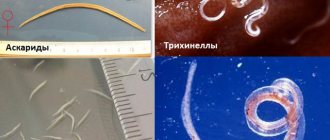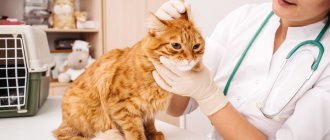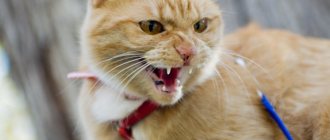Ringworm is the most common fungal disease not only of street cats, but also of domestic cats. In addition, this dermatophytosis is very contagious to people - which is why many of us were forbidden to pet stray animals as children.
Let's find out how dangerous lichen is for humans, what routes of infection there are, and what to do if infection does occur.
What is lichen
Ringworm, or dermatophytosis, is a common fungal disease. Its causative agents are two types of microorganisms: microsporum and trichophiton. Fungi quickly develop in the tissues of the animal, causing infection of the fur, claws and skin.
Feline tinea spreads easily between animals and can also be transmitted to humans. Care items, particles of wool and skin act as an intermediate link.
Interesting! The fungus develops only during the wool growth stage. If hair growth is stopped, then the pathogen becomes harmless. This feature explains the spontaneous recovery of some animals.
The incubation period, according to various sources, ranges from 7 to 14 days. A pronounced clinical picture is typical for cats under one year of age. The reason for this may be:
- lack of nutrients;
- undeveloped cellular immunity;
- viral diseases.
Adult animals get lichen if their immunity is low and if they are under regular stress.
Sources
- Anderson KR: Treatment with dapsone in pityriasis versicolor vesicularis rosea, 1971;
- Andrews GK: Skin Diseases 1954;
- AranjoT. et al.: Human Herpesviruses 6 and 7, 2002;
- Bernhardt R.: Skin diseases: 1922;
- Bjornberg A, Hellgren L: Pityriasis rosea. Statistical, clinical and laboratory research, 1962;
- Buckley K: Rash resembling pityriasis rosea in a patient receiving omeprazole, 1996;
- Gutowski W.: Attempt to treat Gibert's pink dandruff with bismuth and penicillin, 1950;
- Kempf W. et al.: Pityriasis rosea is not associated with human herpes virus, 1999;
- Parson JM et al: Update on pityriasis rosea, 1986;
- Sharma PK, Yadav TP: Erythromycin for pityriasis rosea, 2000;
- Wass I.: Treatment of pityriasis rosea with nonspecific substances, 1948.
ONLINE REGISTRATION at the DIANA clinic
You can sign up by calling the toll-free phone number 8-800-707-15-60 or filling out the contact form. In this case, we will contact you ourselves.
Symptoms and diagnosis of lichen in cats
The main symptom by which it is determined that a cat has lichen is the presence of spots without hair. An animal can be susceptible to four types of lichen, but there are also common symptoms:
- lack of hair;
- skin inflammation;
- severe itching;
- change in skin color;
- peeling.
Each type of lichen is characterized by individual manifestations.
| Type of lichen | Main signs |
| Ringworm | ● small rash on the skin; ● increased anxiety; ● baldness of individual areas on the body; ● round, scaly spots; ● growth of spots and their adoption of an oval shape; ● the appearance of a serous-purulent crust. |
| Tinea versicolor | ● pale oval spots on the skin that grow if left untreated; ● deformation of the claws if they are damaged; ● partial or complete disappearance of stains at low air temperatures. |
| Shingles | ● the appearance of a large number of pink spots on the skin; ● slight itching; ● damage to the groin area, abdomen and the inside of the hind limbs; ● peeling of the inside of the spot; ● increased body temperature; ● enlarged lymph nodes. |
| Ringworm | ● the appearance of red spots on the skin; ● soreness of the affected areas; ● bubbles with liquid in the affected areas; ● the appearance of fever. |
Important! Trichophytosis in cats, which is transmitted to humans, can occur in an atypical form. It is characterized by the absence or mild manifestation of symptoms, which makes timely diagnosis difficult.
Diagnostic features
Diagnosis of lichen involves a visual examination by a veterinarian and examination of the clinical picture. Then the doctor prescribes one of the methods to determine an accurate diagnosis:
- Fluorescent Wood Lamp. Under the influence of its rays, areas with lichen acquire a green tint. However, this method cannot boast of 100% results, therefore it is used as an alternative diagnostic method.
- Examination of particles of fur or skin scrapings under a microscope. The study takes little time, but it is not always possible to identify the pathogen. A negative result does not guarantee the absence of lichen.
- Isolation of fungus in a nutrient medium. The most accurate diagnostic method. It involves the movement of skin particles into a special composition that is favorable for the development of infection. Next, it is observed and studied under a microscope. The main disadvantage of such a study is the long period (up to 3 weeks).
Can you get shingles from a cat?
Feline lichen is transmitted to another animal or person mainly through contact and household contact. Infection can also occur in other ways:
- lichen is transmitted from person to person through objects of regular use (combs, towels);
- in the absence of disinfection of grooming tools in animal salons;
- can be transmitted from cat to person through contact with fur;
- through soil in which the pathogen persists for up to 3 months;
- when working with hay that contains hair from a sick animal.
The risk of contracting lichen from a cat increases with the presence of certain factors:
- low immunity;
- frequent stress, prolonged depression;
- prolonged contact with an infected person;
- constant care of sick animals;
- lack of personal hygiene;
- contact of a child with a lichen-infected cat;
- presence of dermatological diseases.
Signs of the disease in humans
The incubation period for lichen, which can be contracted from a cat, ranges from 2 days to 1.5 months. Most often, the disease manifests itself on days 6–8. Its symptoms differ depending on the location of the outbreak. In general terms, microsporia is represented by an oval pink spot with a rim of a darker color.
Without treatment, the number of plaques increases and they merge with each other. A person with lichen from a cat experiences slight itching in areas of redness.
Important! Feline lichen in humans most often develops when infected through contact and household contact. The use of personal equipment and good hygiene are very important.
Ringworm, which a person could contract from a cat, often affects the scalp. In this case, foci of infection will be represented by a reddened bald spot and a flaky center. And if left untreated, they will begin to increase in size and cause hair loss.
If lichen is transmitted from cats to children, it can become chronic. Moreover, girls are much more susceptible to it than boys. In boys, especially teenagers, it is characterized by a mild course.
Chronic microsporia affects:
- back of the head;
- shoulders;
- scalp;
- joints;
- palms;
- feet;
- nail plates.
Any skin changes are characterized by itching and flaking. Less commonly, a person may experience weakness, fever, and drowsiness.
Period of rash
The type of rash depends on the severity of the disease. At the initial stage, the rashes look like small pink spots located on healthy skin.
If the process develops typically, then the next day they are replaced by bubbles with a clear liquid - grouped vesicles. After 3 days, their contents become cloudy. The rash occurs in spurts, with breaks of several days.
If a severe gangrenous form develops, the filling of the vesicles may be mixed with blood. It seems that the bubbles move to another place, located around the body.
If the form of inflammation is mild, the manifestation of the disease can only be neurological in nature, when the patient feels pain, but there is no rash. This is herpetic neuralgia.
Treatment
A form of feline lichen that is transmitted to humans requires contacting a dermatologist. The doctor will conduct an examination and, if necessary, a more accurate diagnosis. Based on the results, therapy is prescribed that is aimed at combating the fungus.
It includes:
- Drug treatment. Involves taking drugs based on itraconazole. It slows down the synthesis of fungi, which together provides an antifungal effect.
- Local therapy. These are ointments, creams, shampoos based on clotrimazole, mycoseptin, ketoconazole and other active ingredients. As an auxiliary treatment, treatment of the affected areas with iodine solution, sulfur-salicylic ointment, Vidal's milk, and Lassar's paste is prescribed.
In the chronic form, vitamin therapy is additionally administered, immunomodulators and drugs are prescribed that help strengthen the walls of blood vessels. Upon completion of treatment, a second scraping is performed.
In case of a positive result, the treatment regimen is changed; in case of a negative result, the person is considered recovered.
What to do to avoid getting infected
To avoid contracting shingles from a cat, it is enough to follow the rules of personal hygiene and refrain from contact with street animals. Since people with weakened immune systems are susceptible to microsporia, special attention should be paid to children. After all, they strive to stroke even an infectious kitten.
There are general recommendations to avoid getting ringworm in cats:
- wash your hands thoroughly upon arriving home;
- have a cat examined at home by a veterinarian;
- if the animal has access to the street, regularly carry out preventive treatments to find out if the cat has lichen;
- do not contact stray animals and teach your children this;
- If your pet becomes infected, contact your veterinarian and follow his recommendations.
What is usually meant by the name “ringworm” is fungal diseases of the skin and scalp caused by special pathogens - the fungi Microsporum and Trichophyton. The difference between Microsporia and trichophytosis is that it is usually transmitted to humans from a sick animal, while trichophytosis is transmitted among people. These diseases are united by a clinical picture, which is represented by the appearance of flaky lesions with hair breaking off in the affected area. Specific complications include damage to internal organs when fungi penetrate the systemic bloodstream in weakened patients.
Trichophytosis is an anthroponotic (which means it affects people) fungal disease caused by the fungi Trichophyton violaceum and Trichophyton tonsurans. Infection usually occurs through direct contact with the affected areas of the skin of a sick person, or through the use of contaminated household items. Often the disease spreads when sanitary and hygienic rules are not observed in public places (schools, gardens, saunas, hairdressers).
Microsporia is a zooanthroponotic disease (affects both animals and humans) caused by the fungi Microsporum canis and audouinii. In this case, transmission of the disease occurs through contact with sick animals (fox, rabbit, cat, dog, rodents, sheep) or their fur. The peak incidence is observed in early summer and mid-autumn. Infection from person to person is extremely rare. The prevalence of the disease is higher among children and young women; older people get sick very rarely due to the presence of specific organic acids in the skin.
Predisposing factors for the development of ringworm are various chronic somatic diseases - glomerulonephritis, lupus erythematosus, immunodeficiency states, endocrine pathologies (especially diabetes mellitus, adrenal insufficiency), and many others. Immediate risk factors are work related to processing the wool of wild and domestic animals, contact with street animals, and living with a sick person.
Symptoms of the disease with trichophytosis depend on the form of the lesion. There are superficial and chronic forms of the lesion. With a superficial form of damage to the scalp or smooth skin, small or large lesions with irregular contours appear, covered with small scales (while the inflammatory phenomena are practically not expressed). A characteristic symptom is hair breaking off in the affected areas at a level of 1-2 mm above the skin. Externally broken hair looks like black dots deep in the skin, and the surrounding intact hair looks dull and pale.
The chronic form is characterized by the formation of atrophic areas and hair breakage. Individual pale atrophic lesions may be expressed with hair broken off at the skin level (“symptom of blackheads”), diffuse thinning of hair with unpronounced foci of atrophy may occur, as well as a predominance of thinned areas of skin throughout the head with single broken hair.
With microsporia, large foci of peeling 3-5 cm in size appear in the area of the back of the head or crown, as well as small daughter elements, as well as hair breaking off (unlike trichophytosis - 5 mm above the skin level).
A dermato-venereologist is involved in the diagnosis and treatment of fungal infections of the scalp.
Differential diagnosis is most often carried out with seborrhea, pityriasis rosea, and psoriasis.
For diagnosis, it is important to identify lesions and use techniques to identify the pathogen itself. To do this, a microscopic examination of the obtained material for fungi (scraping from the affected area) is used, which is then repeated several times during therapy. After this, the pathogen is cultivated on nutrient media in order to determine its species. Additionally, a general blood test and biochemical blood test are performed before and after therapy (antifungal drugs have severe toxicity).
For trichophytosis and microsporia, the following treatment regimens are used: Griseofulvin orally in 3 doses until a second negative microscopic examination is obtained. After this, every other day, and then once every 3 days until complete recovery. An alternative drug is Terbinafine or Itraconazole. Ointments with Ciclopirox, Ketoconazole or Bifonazole are used locally. Hair in the lesions is shaved every 5-7 days. Treatment takes an average of 1.5 months. The prognosis is favorable in most cases.











